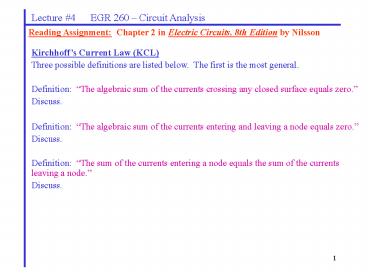EGR 277 Digital Logic - PowerPoint PPT Presentation
1 / 14
Title:
EGR 277 Digital Logic
Description:
Label the currents for a Bipolar Junction Transistor (BJT) and use KCL to find ... To test this, simply check KVL around various paths and KCL at various nodes to ... – PowerPoint PPT presentation
Number of Views:126
Avg rating:3.0/5.0
Title: EGR 277 Digital Logic
1
Lecture 4 EGR 260 Circuit Analysis
Reading Assignment Chapter 2 in Electric
Circuits, 8th Edition by Nilsson
Kirchhoffs Current Law (KCL) Three possible
definitions are listed below. The first is the
most general. Definition The algebraic sum of
the currents crossing any closed surface equals
zero. Discuss. Definition The algebraic sum
of the currents entering and leaving a node
equals zero. Discuss. Definition The sum of
the currents entering a node equals the sum of
the currents leaving a node. Discuss.
2
Lecture 4 EGR 260 Circuit Analysis
Example Use KCL at various closed surfaces and
nodes. Discuss using a sign convention.
3
Lecture 4 EGR 260 Circuit Analysis
Example Apply KCL to node A in the circuit
below. Discuss the difference in a sign due to
convention and a sign due to the value of the
current.
4
Lecture 4 EGR 260 Circuit Analysis
There are times when the most general definition
of KCL is the most powerful. Two examples are
provided below.
Example Find the current I1 in the circuit
shown below.
Example An IEEE standard states that all
currents should be defined as entering a device.
Label the currents for a Bipolar Junction
Transistor (BJT) and use KCL to find the
relationship between the currents.
5
Lecture 4 EGR 260 Circuit Analysis
Series Elements - 2 elements are considered to be
in series if they share one node and no other
element is connected to that node. Use KCL to
show that
Series circuit elements have the same current.
Example Draw an example of a series circuit.
6
Lecture 4 EGR 260 Circuit Analysis
Combining voltage sources Key point Voltage
sources add algebraically in series.
Example
Example Illustrate the well-known fact that
flashlight batteries must be put in the
flashlight with the correct polarity.
7
Lecture 4 EGR 260 Circuit Analysis
Combining voltage sources (continued) Key point
Voltage sources should not be placed in parallel
(unless they have the same voltage).
Example
Practical exception Voltage sources of the same
value are sometimes placed in parallel to
increase the total current capability.
Illustrate how a truck might use two 12Vbatteries.
8
Lecture 4 EGR 260 Circuit Analysis
Combining current sources Key point Current
sources add algebraically in parallel.
Example
Example
9
Lecture 4 EGR 260 Circuit Analysis
Combining current sources (continued) Key point
Current sources should not be placed in series
(unless they have the same current).
Example
Practical exception Current sources of the same
value could be placed in series to increase the
total voltage capability. Illustrate.
10
Lecture 4 EGR 260 Circuit Analysis
Valid versus invalid circuits The text makes a
point that all circuits must always satisfy KVL
and KCL. A circuit that does not satisfy KVL or
KCL is invalid and would be impossible to
construct. A few problems in the text ask is a
circuit is valid. To test this, simply check KVL
around various paths and KCL at various nodes to
insure that no invalid equations occur.
Example Is the following circuit valid?
Example Is the following circuit valid?
11
Lecture 4 EGR 260 Circuit Analysis
Example Find I1, I2, and V3 in the circuit
shown below.
12
Lecture 4 EGR 260 Circuit Analysis
Example Find V1, V2, and I3 in the circuit
shown below. Also show that Pgenerated
Pabsorbed for the circuit below (true for any
circuit).
13
Lecture 4 EGR 260 Circuit Analysis
Example (Problem 2-11 in Electric Circuits, by
Nilsson). Find ig, ia, vg, and the total power
developed in the circuit shown below.
14
Lecture 4 EGR 260 Circuit Analysis
Example (Problem 2-15 in Electric Circuits, by
Nilsson). If ia 4A and ib 2A, find ig, vg,
and the power dissipated by each resistor.































